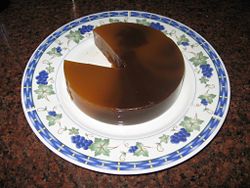Dulce de batata: Difference between revisions
Appearance
Content deleted Content added
No edit summary |
No edit summary |
||
| Line 15: | Line 15: | ||
| other = |
| other = |
||
}} |
}} |
||
'''Dulce de batata''' (in {{lang-es|sweet potato candy}}, or: sweet potato jam) is a traditional [[Argentine cuisine|Argentine]], [[Paraguay]]an, [[Uruguay|Uruguayan]], [[Chile|Chilean]] (where it's known as Dulce de Camote) and [[Brazil]]ian [[dessert]], which is made of [[sweet potato]]es. It is a sweet [[Fruit preserves|jelly]], which resembles a [[marmalade]] because of its hard texture. In Brazil it is known as marrom glacê. |
'''Dulce de batata''' (in {{lang-es|sweet potato candy}}, or: sweet potato jam) or '''Doce de batata doce''' (Portuguese expression with the same meaning) is a traditional [[Argentine cuisine|Argentine]], [[Paraguay]]an, [[Uruguay|Uruguayan]], [[Chile|Chilean]] (where it's known as Dulce de Camote) and [[Brazil]]ian [[dessert]], which is made of [[sweet potato]]es. It is a sweet [[Fruit preserves|jelly]], which resembles a [[marmalade]] because of its hard texture. In Brazil it is known as marrom glacê. |
||
When sold commercially, it is often found [[canning|canned]] in flat and round metal cans. In some of the commercial versions of the food, [[chocolate]] is added to it. |
When sold commercially, it is often found [[canning|canned]] in flat and round metal cans. In some of the commercial versions of the food, [[chocolate]] is added to it. |
||
Revision as of 15:32, 2 November 2014
 Dulce de batata with an addition of chocolate that was sold in a can | |
| Type | Dessert |
|---|---|
| Main ingredients | Sweet potatoes |
Dulce de batata (in Spanish: sweet potato candy, or: sweet potato jam) or Doce de batata doce (Portuguese expression with the same meaning) is a traditional Argentine, Paraguayan, Uruguayan, Chilean (where it's known as Dulce de Camote) and Brazilian dessert, which is made of sweet potatoes. It is a sweet jelly, which resembles a marmalade because of its hard texture. In Brazil it is known as marrom glacê.
When sold commercially, it is often found canned in flat and round metal cans. In some of the commercial versions of the food, chocolate is added to it.
It is commonly eaten with crackers and/or cheese.
